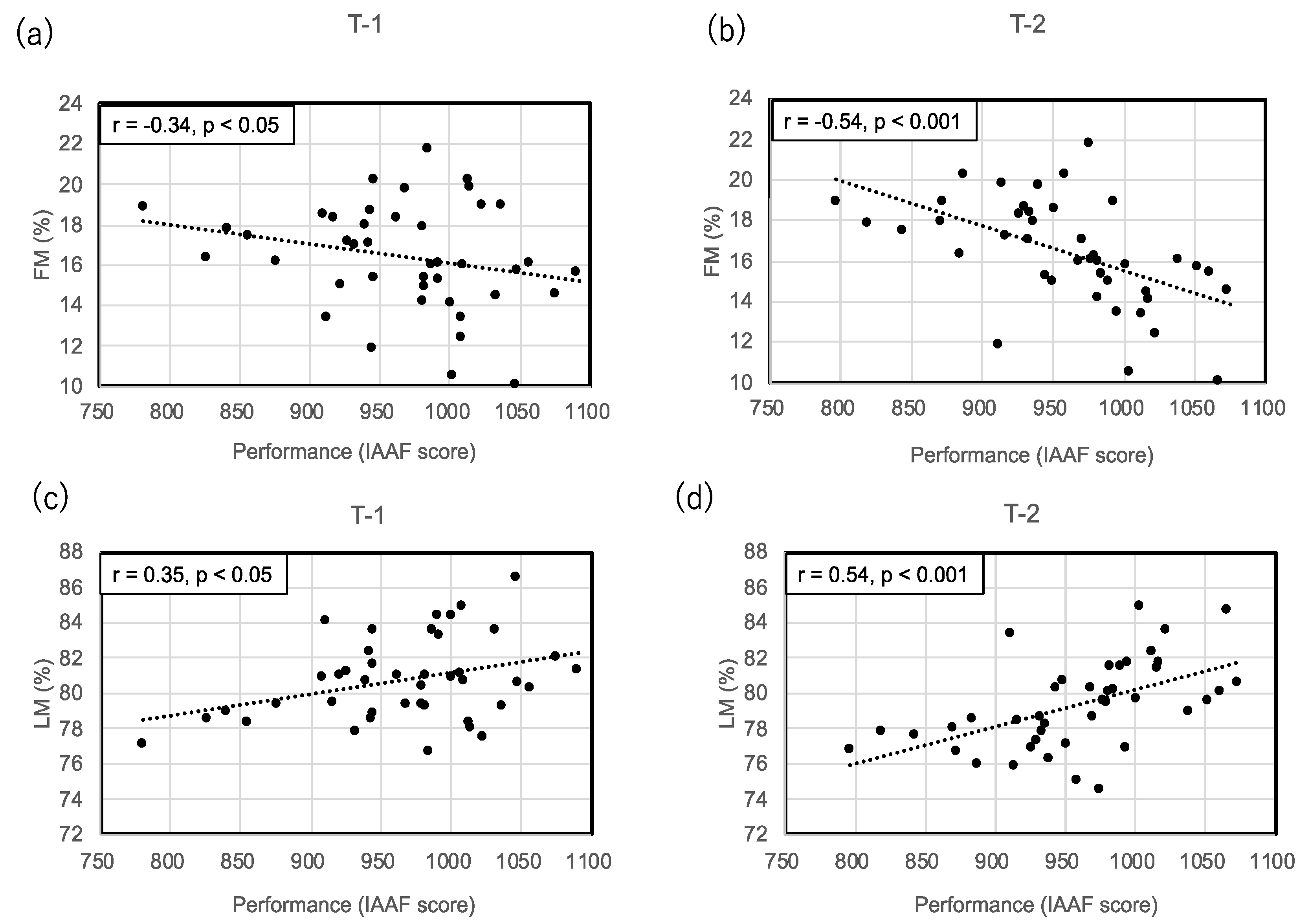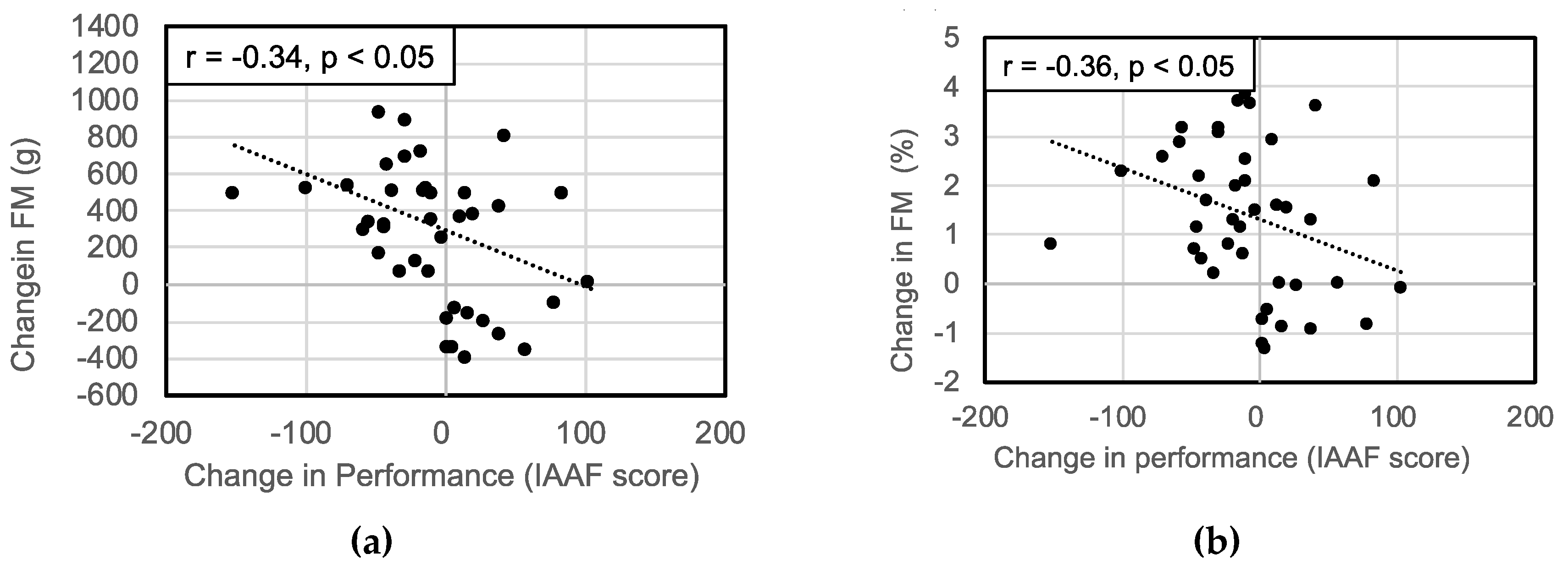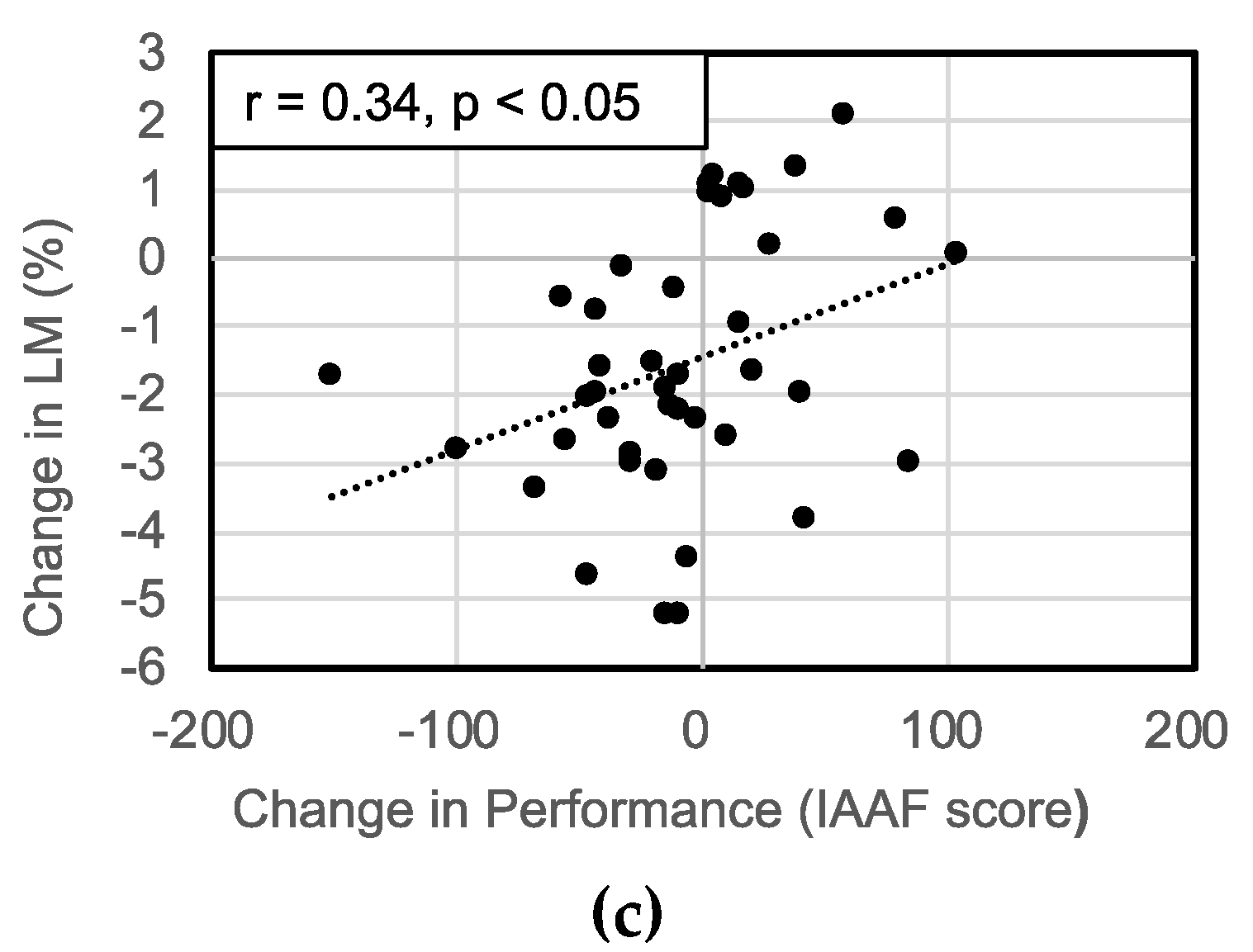Changes in Body Composition and Its Relationship to Performance in Elite Female Track and Field Athletes Transitioning to the Senior Division
Abstract
:1. Introduction
2. Materials and Methods
2.1. Subjects
2.2. Design
2.3. Season Performance
2.4. Height, Weight, and Body Composition
2.5. Training Schedules
2.6. Statistical Analysis
3. Results
Association between Performance and Body Composition
- Total body
- Upper extremities
- Trunk
- Lower extremities
4. Discussion
5. Conclusions
Author Contributions
Funding
Acknowledgments
Conflicts of Interest
References
- World Athletics, World U20 Records. Available online: https://www.worldathletics.org/records/by-category/world-u20-records (accessed on 10 June 2020).
- All Japan High School Athletic Federation. Available online: http://www.zen-koutairen.com/pdf/reg-29-nen.pdf (accessed on 15 June 2020).
- Boccia, G.; Moisè, P.; Franceschi, A.; Trova, F.; Panero, D.; La Torre, A.; Rainoldi, A.; Schena, F.; Cardinale, M. Career performance trajectories in track and field jumping events from youth to senior success: The importance of learning and development. PLoS ONE 2017, 12, e0170744. [Google Scholar] [CrossRef]
- All Japan High School Athletic Federation. Available online: http://www.zen-koutairen.com/f_regist.html (accessed on 25 May 2020).
- Track and Field Ranking. Available online: https://rikumaga.com/top (accessed on 14 June 2020).
- The Inter-University Athletics Union of Japan, 2017 Annual Report. Available online: https://iuau.jp/gakurentouroku.html (accessed on 14 June 2020).
- Hollings, S.C.; Mallett, C.J.; Hume, P.A. The transition from elite junior track-and-field athlete to successful senior athlete: Why some do, why others don’t. Int. J. Sports Sci. Coach. 2014, 9, 457–471. [Google Scholar] [CrossRef]
- Mohamed, H.; Vaeyens, R.; Matthys, S.; Multael, M.; Lefevre, J.; Lenoir, M.; Philppaerts, R. Anthropometric and performance measures for the development of a talent detection and identification model in youth handball. J. Sports Sci. 2009, 27, 257–266. [Google Scholar] [CrossRef] [PubMed]
- Pion, J.; Segers, V.; Fransen, J.; Debuyck, G.; Deprez, D.; Haerens, L.; Vaeyens, R.; Philippaerts, R.; Lenoir, M. Generic anthropometric and performance characteristics among elite adolescent boys in nine different sports. Eur. J. Sport Sci. 2015, 15, 357–366. [Google Scholar] [CrossRef] [PubMed]
- Dessalew, G.W.; Woldeyes, D.H.; Abegaz, B.A. The Relationship between anthropometric variables and race performance. Open Access J. Sports Med. 2019, 10, 209–216. [Google Scholar] [CrossRef] [Green Version]
- Sánchez Muñoz, C.; Muros, J.J.; López Belmonte, Ó.; Zabala, M. Anthropometric characteristics, body composition and somatotype of elite male young runners. Int. J. Environ. Res. Public Health 2020, 17, 674. [Google Scholar] [CrossRef] [Green Version]
- Martín-Matillas, M.; Valadés, D.; Hernández-Hernández, E.; Olea-Serrano, F.; Sjöström, M.; Delgado-Fernández, M.; Ortega, F.B. Anthropometric, body composition and somatotype characteristics of elite female volleyball players from the highest Spanish league. J. Sports Sci. 2014, 32, 137–148. [Google Scholar] [CrossRef]
- Brown, L.M.; Clegg, D.J. Central effects of estradiol in the regulation of food intake, body weight, and adiposity. J. Steroid Biochem. Mol. Biol. 2010, 122, 65–73. [Google Scholar] [CrossRef] [Green Version]
- Loomba-Albrecht, L.A.; Styne, D.M. Effect of puberty on body composition. Curr. Opin. Endocrinol. Diabetes Obes. 2009, 16, 10–15. [Google Scholar] [CrossRef]
- Wells, J.C. Sexual dimorphism of body composition. Best Pract. Res. Clin. Endocrinol. Metab. 2007, 21, 415–430. [Google Scholar] [CrossRef]
- Matsuda, T.; Kiyonaga, K.; Mamizuka, N.; Hiyama, S.; Goto, M.; Tateishi, T.; Kato, H.; Dohi, M. Discussion of the relationship between the longitudinal changes in lean body mass and the performance of young elite female soccer players. J. High Perform. Sport 2019, 4, 61–70. [Google Scholar]
- Arrese, A.L.; Ostariz, E.S. Skinfold thicknesses associated with distance running performance in highly trained runners. J. Sports Sci. 2006, 24, 69–76. [Google Scholar] [CrossRef] [PubMed]
- Legaz, A.; Eston, R. Changes in performance, skinfold thicknesses, and fat patterning after three years of intense athletic conditioning in high level runners. Br. J. Sports Med. 2005, 39, 851–856. [Google Scholar] [CrossRef] [PubMed] [Green Version]
- Hirsch, K.R.; Smith-Ryan, A.E.; Trexler, E.T.; Roelofs, E.J. Body composition and muscle characteristics of division I track and field athletes. J. Strength Cond. Res. 2016, 30, 1231–1238. [Google Scholar] [CrossRef] [PubMed] [Green Version]
- IAAF Scoring Tables of Athletics. Available online: https://www.worldathletics.org/news/iaaf-news/scoring-tables-2017 (accessed on 9 July 2020).
- Legaz-Arrese, A.; Kinfu, H.; Munguia-Izquierdo, D.; Carranza-Garcia, L.E.; Calderon, F.J. Basic physiological measures determine fitness and are associated with running performance in elite young male and female Ethiopian runners. J. Sports Med. Phys. Fitness 2009, 49, 358–363. [Google Scholar] [PubMed]
- Garcia-Gil, M.; Torres-Unda, J.; Esain, I.; Duñabeitia, I.; Gil, S.M.; Gil, J.; Irazusta, J. Anthropometric parameters, age, and agility as performance predictors in elite female basketball players. J. Strength Cond. Res. 2018, 32, 1723–1730. [Google Scholar] [CrossRef] [PubMed]
- Stoggl, T.; Enqvist, J.; Muller, E.; Holmberg, H.C. Relationships between body composition, body dimensions, and peak speed in cross-country sprint skiing. J. Sports Sci. 2010, 28, 161–169. [Google Scholar] [CrossRef]
- Larsson, P.; Henriksson-Larsén, K. Body composition and performance in cross-country skiing. Int. J. Sports Med. 2008, 29, 971–975. [Google Scholar] [CrossRef]
- Hoshikawa, Y.; Muramatsu, M.; Iida, T.; Uchiyama, A.; Nakajima, Y.; Kanehisa, H. Event-related differences in the cross-sectional areas and torque generation capabilities of quadriceps femoris and hamstrings in male high school athletes. J. Physiol. Anthropol. 2010, 29, 13–21. [Google Scholar] [CrossRef] [Green Version]
- Smith-Rockwell, M.; Nickols-Richardson, S.M.; Thye, F.W. Nutrition knowledge, opinions, and practices of coaches and athletic trainers at a division 1 university. Int. J. Sport Nutr. Exerc. Metab. 2001, 11, 174–185. [Google Scholar] [CrossRef] [Green Version]
- De Souza, M.J.; Nattiv, A.; Joy, E.; Misra, M.; Williams, N.I.; Mallinson, R.J.; Gibbs, J.C.; Olmsted, M.; Goolsby, M.; Matheson, G. 2014 female athlete triad coalition consensus statement on treatment and return to play of the female athlete triad: 1st International Conference held in San Francisco, California, May 2012 and 2nd International Conference held in Indianapolis, Indiana, May 2013. Br. J. Sports Med. 2014, 48, 289. [Google Scholar] [CrossRef] [PubMed] [Green Version]
- Statuta, S.M.; Asif, I.M.; Drezner, J.A. Relative energy deficiency in sport (RED-S). Br. J. Sports Med. 2017, 51, 1570–1571. [Google Scholar] [CrossRef] [PubMed]
- Kang, M.J.; Hong, H.S.; Chung, S.J.; Lee, Y.A.; Shin, C.H.; Yang, S.W. Body composition and bone density reference data for Korean children, adolescents, and young adults according to age and sex: Results of the 2009–2010 Korean National Health and Nutrition Examination Survey (KNHANES). J. Bone Miner. Metab. 2016, 34, 429–439. [Google Scholar] [CrossRef] [PubMed]
- Kooreman, Z.; Giraldeau, G.; Finocchiaro, G.; Kobayashi, Y.; Wheeler, M.; Perez, M.; Moneghetti, K.; Oxborough, D.; George, K.P.; Myers, J.; et al. Athletic remodeling in female college athletes: The “Morganroth Hypothesis” revisited. Clin. J. Sport Med. 2019, 29, 224–231. [Google Scholar] [CrossRef]
- Cheung, A.T.H.; Ma, A.W.W.; Fong, S.S.M.; Chung, L.M.Y.; Bae, Y.H.; Liu, K.P.Y.; Kam, K.W.K.; Chung, J.W.Y. A comparison of shoulder muscular performance and lean mass between elite and recreational swimmers: Implications for talent identification and development. Medicine 2018, 97, e13258. [Google Scholar] [CrossRef]
- Sarnblad, S.; Ekelund, U.; Aman, J. Dietary fat intake predicts 1-year change in body fat in adolescent girls with type 1 diabetes. Diabetes Care 2006, 29, 1227–1230. [Google Scholar] [CrossRef] [Green Version]
- Nana, A.; Slater, G.J.; Stewart, A.D.; Burke, L.M. Methodology review: Using dual-energy X-ray absorptiometry (DXA) for the assessment of body composition in athletes and active people. Int. J. Sport Nutr. Exerc. Metab. 2015, 25, 198–215. [Google Scholar] [CrossRef]
- Houska, C.L.; Kemp, J.D.; Niles, J.S.; Morgan, A.L.; Tucker, R.M.; Ludy, M.J. Comparison of body composition measurements in lean female athletes. Int. J. Exerc. Sci. 2018, 11, 417–424. [Google Scholar]




| T-1 | T-2 | Changes from T-1 to T-2 | t Value | p Value | |
|---|---|---|---|---|---|
| Age (years) | 17.7 ± 0.6 | 18.6 ± 0.6 | 1.0 ± 0.0 | 129.01 | <0.001 |
| Height (cm) | 162.8 ± 5.2 | 163.0 ± 5.2 | 0.2 ± 0.6 | 1.59 | 0.12 |
| Body weight (kg) | 53.6 ± 5.3 | 54.2 ± 5.0 | 0.6 ± 1.6 | 2.36 | 0.02 |
| BMI (kg/m2) | 20.2 ± 1.6 | 20.4 ± 1.6 | 0.2 ± 0.6 | 2.09 | 0.04 |
| IAAF Score | 967.1 ± 66.8 | 958.6 ± 64.3 | −8.4 ± 47.1 | 1.16 | 0.25 |
| Training hours on weekdays (hours/day) | 2.8 ± 0.6 | 2.8 ± 0.6 | −0.1 ± 0.8 | 0.53 | 0.60 |
| Training hours on weekends (hours/day) | 3.5 ± 0.9 | 3.6 ± 0.7 | 0.0 ± 0.8 | 0.36 | 0.72 |
| Whole Body | T-1 | T-2 | Changes from T-1 to T-2 | tValue | pValue |
| TM (kg) | 53.6 ± 5.3 | 54.2 ± 5.0 | 0.6 ± 1.6 | 2.36 | 0.02 |
| LM (kg) | 43.2 ± 3.7 | 42.9 ± 3.5 | −0.3 ± 1.3 | 1.46 | 0.15 |
| FM (kg) | 8.1 ± 1.9 | 9.0 ± 2.0 | 0.8 ± 0.9 | 5.76 | <0.001 |
| BMC (g) | 2239.8 ± 249.7 | 2293.0 ± 231.1 | 53.2 ± 76.3 | 4.52 | <0.001 |
| LM (%) | 80.8 ± 2.3 | 79.3 ± 2.5 | −1.5 ± 1.5 | 6.22 | <0.001 |
| FM (%) | 15.0 ± 2.4 | 16.4 ± 2.6 | 1.4 ± 1.5 | 5.86 | <0.001 |
| BM (%) | 4.2 ± 0.4 | 4.2 ± 0.4 | 0.1 ± 0.1 | 2.47 | 0.02 |
| Upper Extremities | T-1 | T-2 | Changes from T-1 to T-2 | tValue | pValue |
| TM (kg) | 5.5 ± 0.6 | 5.4 ± 0.5 | −0.1 ± 0.4 | 1.37 | 0.18 |
| LM (kg) | 4.3 ± 0.4 | 4.2 ± 0.4 | −0.1 ± 0.2 | 3.09 | <0.01 |
| FM (kg) | 0.9 ± 0.3 | 1.0 ± 0.2 | 0.0 ± 0.2 | 1.64 | 0.11 |
| BMC (g) | 266.1 ± 31.6 | 264.7 ± 26.5 | −1.4 ± 15.4 | 0.61 | 0.55 |
| LM (%) | 78.8 ± 3.8 | 77.5 ± 3.5 | −1.2 ± 2.6 | 3.01 | <0.01 |
| FM (%) | 16.4 ± 4.0 | 18.3 ± 3.9 | 1.9 ± 2.8 | 4.38 | <0.001 |
| BM (%) | 4.9 ± 0.4 | 4.9 ± 0.4 | 0.0 ± 0.2 | 1.29 | 0.21 |
| Trunk | T-1 | T-2 | Changes from T-1 to T-2 | tValue | pValue |
| TM (kg) | 23.7 ± 2.5 | 24.2 ± 2.4 | 0.5 ± 0.8 | 3.97 | <0.001 |
| LM (kg) | 20.3 ± 1.9 | 20.3 ± 1.8 | 0.0 ± 0.7 | 0.07 | 0.95 |
| FM (kg) | 2.7 ± 0.7 | 3.2 ± 0.9 | 0.5 ± 0.5 | 6.21 | <0.001 |
| BMC (g) | 610.2 ± 78.8 | 629.3 ± 79.7 | 19.1 ± 20.8 | 5.96 | <0.001 |
| LM (%) | 86.0 ± 2.3 | 84.2 ± 2.8 | −1.8 ± 1.9 | 6.03 | <0.001 |
| FM (%) | 11.5 ± 2.4 | 13.2 ± 2.9 | 1.7 ± 1.9 | 5.87 | <0.001 |
| BM (%) | 2.6 ± 0.3 | 2.6 ± 0.3 | 0.0 ± 0.1 | 1.69 | 0.10 |
| Lower Extremities | T-1 | T-2 | Changes from T-1 to T-2 | tValue | pValue |
| TM (kg) | 19.8 ± 2.2 | 19.9 ± 2.2 | 0.1 ± 0.7 | 1.14 | 0.26 |
| LM (kg) | 15.4 ± 1.5 | 15.2 ± 1.5 | −0.2 ± 0.6 | 2.42 | 0.02 |
| FM (kg) | 3.6 ± 0.9 | 3.9 ± 0.9 | 0.3 ± 0.4 | 4.91 | <0.001 |
| BMC (g) | 858.9 ± 99.6 | 869.0 ± 96.9 | 10.2 ± 30.6 | 2.15 | 0.04 |
| LM (%) | 77.8 ± 3.1 | 76.2 ± 3.2 | −1.6 ± 1.9 | 5.37 | <0.001 |
| FM (%) | 17.8 ± 3.1 | 19.4 ± 3.2 | 1.5 ± 1.9 | 5.19 | <0.001 |
| BM (%) | 4.4 ± 0.4 | 4.4 ± 0.4 | 0.0 ± 0.2 | 0.98 | 0.33 |
© 2020 by the authors. Licensee MDPI, Basel, Switzerland. This article is an open access article distributed under the terms and conditions of the Creative Commons Attribution (CC BY) license (http://creativecommons.org/licenses/by/4.0/).
Share and Cite
Tsukahara, Y.; Torii, S.; Yamasawa, F.; Iwamoto, J.; Otsuka, T.; Goto, H.; Kusakabe, T.; Matsumoto, H.; Akama, T. Changes in Body Composition and Its Relationship to Performance in Elite Female Track and Field Athletes Transitioning to the Senior Division. Sports 2020, 8, 115. https://doi.org/10.3390/sports8090115
Tsukahara Y, Torii S, Yamasawa F, Iwamoto J, Otsuka T, Goto H, Kusakabe T, Matsumoto H, Akama T. Changes in Body Composition and Its Relationship to Performance in Elite Female Track and Field Athletes Transitioning to the Senior Division. Sports. 2020; 8(9):115. https://doi.org/10.3390/sports8090115
Chicago/Turabian StyleTsukahara, Yuka, Suguru Torii, Fumihiro Yamasawa, Jun Iwamoto, Takanobu Otsuka, Hideyuki Goto, Torao Kusakabe, Hideo Matsumoto, and Takao Akama. 2020. "Changes in Body Composition and Its Relationship to Performance in Elite Female Track and Field Athletes Transitioning to the Senior Division" Sports 8, no. 9: 115. https://doi.org/10.3390/sports8090115





